

More tall Tharp tales
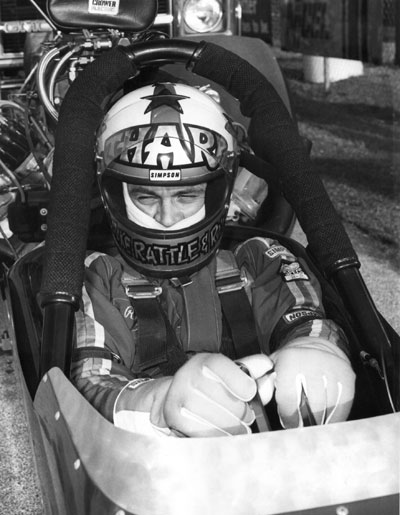 |
Apparently, the world loves a good Richard Tharp story.
Response to Friday’s column about “King Richard” was off the charts. I guess I could have predicted that, but still I was amazed at the outpouring of kudos to me and affection for Tharp, who called that morning to tell me that his phone began ringing at 6:45 with calls from old friends telling him about the article, which he hadn’t yet risen to read. Nine calls later, he figured he’d best get up and read what all the commotion was about.
Well, if they enjoyed the opener, today’s follow-up will probably make their day, too. I’ve been amassing a small collection of Tharp stories voluntarily submitted for today’s follow-up and asking others to share theirs, but from the latter group, I keep getting the same response (almost to the word): “Nothing that you could publish.” Nevertheless, we have some stories to tell.
(Before I proceed, I think it’s important to preface all of this by noting that the drag racing world in which Tharp and company operated in the late 1960s and 1970s was pretty much an alien world compared to the one we know today and that by retelling the stories, I’m not condoning them or the behavior they constitute. Many of the shenanigans occurred outside of the sphere of influence of NHRA events, on the road to match races and elsewhere, and even those that did happen in the NHRA world occurred in a different culture and political climate from today’s buttoned-down world, and today’s stringent testing policies serve as a major deterrent to excessive indulgences during race weekend. I share them to try to accurately reflect on a period of drag racing’s growth from which many of the characters we know came to be legendary on many fronts.)
Anyway, one CYA later, on with the stories …
Former NHRA Top Fuel racer Carl Olson knows Tharp from their years of competition on the track in the 1970s and as an NHRA official after he left the cockpit. On Friday, I related the story of Tharp’s crash at the 1979 Fallnationals in Seattle, where Tharp was knocked out by tire shake and left the racing surface at high speed, an incident to which Olson was a firsthand witness.
“Back in those days, the guardrails at SIR were set well back from the track surface,” Olson remembered. “The car got upside down and went scraping through the grass and mud while shedding parts in every direction. Just past the finish line, there was a gravel service road perpendicular to the track that was used by facility maintenance vehicles as a means for getting from one side of the track to the other. When Richard’s car went across that road upside down, it went into a violent series of rolls.
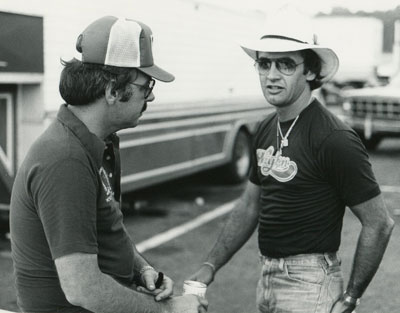
"Just gimme my damned pants, Paul ..."
|
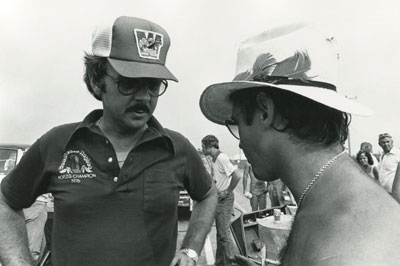
"No ..."
|
“I observed this incident from my vantage point at the finish line and immediately jumped on my motorcycle. The first two people to get to the wreckage were the NHRA Safety Safari’s Alan Miller and me. We discovered the roll cage upright and Richard very much unconscious. We immediately noted that while upside down, Richard’s full-face helmet had become packed inside with grass, mud, and gravel. We couldn’t see any part of his face. In spite of our training that advised against moving a victim’s head to prevent potential neck and spinal-cord injuries, we recognized that if we didn’t take immediate steps to remove the mud and gravel, Richard would suffocate. While Alan tipped Richard’s helmet back, I reached inside from under his chin and through his visor opening and cleared away enough of the mud to provide an airway to his nose and mouth. Shortly thereafter, the full Safety Safari team arrived along with the event doctor. As they were working to stabilize and extricate Richard, he regained consciousness and became, well, the best way I can describe it is extremely combative. He just kept telling everyone to go away and leave him alone, and he was flailing away at anyone that tried to touch him.
“When Richard was finally extricated, his helmet removed and firesuit cut away, he unleashed a barrage of foul language that included virtually every curse word I’d ever heard. In spite of the doctor’s orders for him to be transported to the local emergency room for evaluation and treatment, Richard steadfastly refused to go. He just kept saying that he wanted to go back to his hotel. Paul Candies had wisely hidden Richard’s trousers in their trailer and refused to get them for him. As a result, Richard had no choice but to sit in the ambulance for several hours while the doctor and attendants kept an eye on him. After Richard threatened to kick the asses of everyone in a one-mile radius, Candies finally relented and fetched his pants and a clean shirt. He was then given a ride to his hotel, where I’m told that he had dinner and retired for the night. He flew back to Dallas the next morning. Tough guy? Oh yeah, he’s as tough as they come.”
As NHRA’s competition director, Steve Gibbs also knew Tharp well, both on and off the track. “He was the kind of guy who would do just about anything you could think about doing but not do yourself,” he assessed. “He was a helluva race car driver, though. I’ll never forget when he almost got together with Gary Read at Indianapolis. I don’t know how he kept them from crashing.”
 |
In one of the wildest moments of Tharp’s long career – and one of the few that he’ll admit ever frightened him – Read’s Over The Hill Gang dragster crossed wildly into Tharp’s lane in the second round of the 1977 Big Go. As the amazing Richard Brady photo at right attests, Read took over well more than half of Tharp’s lane, but Tharp deftly dived the Candies & Hughes car to the right to avoid what would have been a nasty collision and still went 6.26 at 185 mph to get the win en route to a runner-up finish.
“When I got down there, I expected to find Richard all over Read," said Gibbs, "but he was off sitting by himself, terrified that he’d come that close to a major crash.”
“It scared the hell out of me,” Tharp confessed to me Friday. “I looked over out my left side at about three-quarters of the way down there, and his front tire was about 2 inches from me. I scooted over and almost hit the guardrail and then back to the other side of the track. It was really, really scary. I got out and had to sit out there in the cornfield for a few minutes. It scared [car owners Paul] Candies and Leonard [Hughes] worse than it did me. I thought Candies was ready to quit.
“I was so scared I didn’t think about trying to beat the [crap] out of Read like I did Marvin Graham when we won at that first Cajun Nationals [1976]. I thought that he had burned me down on the starting line in the final, so when I got out of the car at the other end, took my helmet off, and I tried beat the [crap] out of him, except he still had his helmet on. The next day, my fists were all swollen up.”
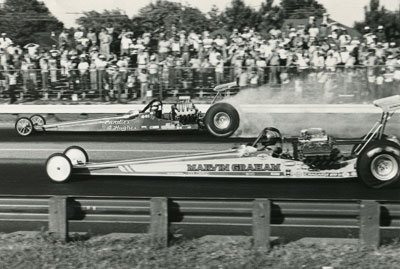 |
I called Graham yesterday, and he confirmed the ill-advised attack. “I was just getting out of the car, and he starts swinging and hitting me in the head. I remember thinking, ‘That’s not a smart thing for him to do,’ and when he got done, I asked him, ‘Um, Richard … did you notice that you won? I lost. What are you upset about?’ ”
I asked Graham, who lost a tire-smoking battle, 6.35 to 6.61, why Tharp thought he’d burned him down. “Because I probably did,” he answered honestly. “I might have taken a little extra time. We all did that from time to time back then because there was no rule against it. Plus Richard was driving for Candies & Hughes and had a late-model [Hemi] that would get hot faster, and I was still driving my old flathead [Donovan] that didn’t care if it was hot or cold.”
The late, great Ronnie Sox also was “attacked” by Tharp, but in a much different manner, remembered Hall of Fame photographer Steve Reyes. “At the 1972 IHRA Bristol, Tenn., race, there was a huge racers’ party at the Holiday Inn in Bristol. Tharp, being the party animal, pulled Sox’s bathing shorts to the ground to the cheers of all the racers present. Sox calmly bent over and calmly pulled them up and waved to the very drunk crowd. That was also the party Tharp introduced me to ‘white lightning,’ which he had put in the party ‘punch.’ God, did I have a hangover.”
Olson remembers another eye-opening incident with Tharp on the IHRA tour: "[Partner Mike] Kuhl and I were sitting around the pool at a Holiday Inn in Southern Pines, N.C., while participating in the IHRA Pro Am at Rockingham and observed Richard walking around the second floor walkway dressed in nothing but a cowboy hat and pair of cowboy boots, then approach a room where he knocked on the door. A gorgeous female opened the door and immediately invited Richard in. He was still there much later when we finally called it a night and went to our room.”
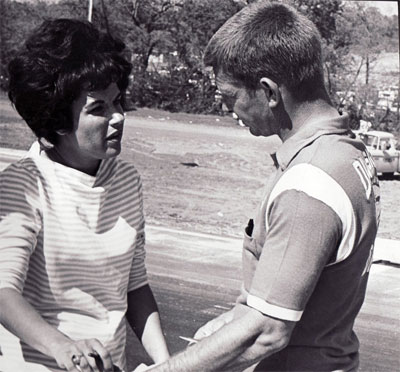
Glynanna and Dale Ham: "You loaned our car to Tharp? Are you crazy?"
|
Nudity and Tharp, I guess, were good friends. Gibbs related a story shared with him by former Division 4 Director Dale Ham, who had loaned his official station wagon to Tharp one weekend during a points meet in Amarillo. Tharp, who was famous for accepting dares – eat a bird, eat a bar of soap, stuff like that – was driving around with his buddies, and one friend dared him to take off his clothes and get out of the car at the next intersection while they drove around the block and picked him up in a few minutes. Tharp – about the same size and build as Ham – naturally, had to oblige, dropped trou, and stepped out of the car, naked as the day he was born.
Coincidentally and very unfortunately, inside a restaurant at that same intersection sat Ham’s in-laws, sharing a meal with good friends and bragging about the fine man that their daughter, Glynanna, had married, and, oh, look, there’s his car now ...
“The reception Dale got at church the next Sunday was pretty cold,” Gibbs noted.
Graham, who raced against Tharp in the Division 4 Top Fuel wars in the 1970s, told a Tharp tale similar to a Dave Densmore story that I shared Friday about Tharp being asked to make a checkout pass for a team whose driver was having problems. He’s pretty sure it was the Carroll brothers car that Tharp had driven before and would drive again. “I can’t remember who the driver was, but he’d get the car to half-track and shut off and was complaining that the car had a terrible vibration,” recalled Graham. “So they went over and grabbed Richard and said, ‘Richard, run this car on down through there,’ and he made a really nice pass, got out at the other end, and told the other driver, ‘That car’s not vibrating; that’s the earth around you vibrating.’ ”
If there’s one thing that became crystal clear from the many stories I’ve heard and read, it's that although Tharp is the guy you’d want behind the wheel of your race car, he most definitely was not the guy you wanted behind the wheel while you were a passenger in his street car. Or the guy on the road next to him. Or even the guy in the passenger seat while you were driving.
Reyes remembered an episode from that same Bristol IHRA event. “A group of us photogs were driving back to the motel that evening; we pulled alongside the Blue Max rig with Tharp,” he said. “We waved, and, of course, Tharp tried to run us off the road. Again we pulled alongside, and Tharp was laughing his butt off at our almost off-road venture. This time, we were ready, and armed with 200-watt strobes, we blasted the rig. In our rearview mirror, we saw the Blue Max rig making a frantic stop on the shoulder. Tharp still complains to this day about blinding him on that dark road leaving the racetrack. In the magazine I did for Argus in 1972 called Hot Rodding in Action, the intro page has a photo that Jeff Tinsley took the day after our ‘strobe’ evening. Tharp is standing on my feet and holding my jacket and looking up at my chin. [Tharp stands a good foot shorter than Reyes.] I have a smile on my face and Tharp does also.”

NHRA's Jack Hart
|
Both Tharp and Gibbs related to me a story of an infamous car ride during the 1970 World Finals in Dallas. Tharp had invited NHRA Executive Director Jack Hart – perhaps at the time the most powerful man in drag racing – his wife, Hazel, and Gibbs out to dinner. As Tharp is driving them all down some Dallas freeway, he casually asks Hart where his invitation is to the upcoming Supernationals. That inaugural event, held at Ontario Motor Speedway, was an invitation-only race that first year, and, well, Tharp was not being invited.
“Hart kinda hemmed and hawed and finally told Tharp that the invitations were based on the number of NHRA races that the person had run, and that since he had not been to the required number, unfortunately, there would be no invitation,” remembered Gibbs. “Without hesitation, Tharp slammed on the brakes -- in real heavy traffic -- put the car in park, threw the keys on the floor, and said he would not move the car until he was invited to Ontario! Hazel was in an absolute panic, and it scared the hell out of me. It took about 10 seconds for Hart to see that Hazel was on the verge of a heart attack and said to Richard, ‘Whatever you want ... just get us the hell out of here.’ Tharp got his invitation the next day. I’m sure Jack found some loophole to get him in.”
In Tharp’s version, he tossed the keys into Hart’s lap in the backseat and the aforementioned Glynanna Ham also was in the car, but the details didn’t matter as much as his colorful description of the mayhem that ensued, which included cars skidding past them sideways trying not to hit the stopped car.
Gibbs recalled another wild ride with Tharp at the U.S. Nationals: “We were trying to get to the Car Craft banquet, and I was riding with Tharp, but we couldn’t find an on-ramp for the freeway. He found an off-ramp, drove down it, hooked a U-turn, and we were on the freeway. Being in a car with him was always a thrill a minute.”

Norman "Moose" Pearah, left, with NHRA's Wally Parks, 1978 Cajun Nationals
|
Tharp also recalled a memorable Denver car ride with the legendary Norman “Moose” Pearah, a former NFL football player who stood 6-foot-6 and who at the time owned both State Capitol Dragway (home of the Cajun Nationals) and Atlanta Dragway (home of the Southern Nationals). The two free spirits shared a connection out of Dallas headed for the mile-high city and, naturally, enjoyed some of the airline’s cocktails along the way before piling into Pearah’s Cadillac rental car. They proceeded to get a little more lubricated later that night and closed down a local establishment, then set out to follow a couple of girls to a nearby party.
“When we go outside, it was raining so hard we couldn’t see, and ‘Moose’ was getting upset because he couldn’t see to follow the girls,” Tharp recalled. “He had the windshield wipers up as fast as they could go, but it was raining so hard he couldn’t see. So I just reached up with my cowboy boots and pushed the windshield off the car. It fell onto the hood and then off the side of the car, and the wipers were still going, wiping the dash off. I said, ‘How’s that?’ and ‘Moose’ yells over at me, ‘That’s a lot better, but roll up your window. I’m getting wet.’ Man, I’ve told that story so many times, and it always gets a big laugh.”
Tharp’s tale Friday about trying to get more than three dozen backstage passes for his friends from pal Willie Nelson dovetails nicely with Gibbs’ experience trying to attend a Nelson concert with Tharp at the Universal Amphitheater, not far from NHRA’s then headquarters in North Hollywood.
“Richard invited us all to meet him at the Sheraton hotel next to the concert to get our tickets,” Gibbs remembered. "He was kind of antsy because his ticket guy hadn’t shown up, but he kept telling us, ‘Don’t worry about it.’ Finally, it got to maybe a half-hour before showtime, and we still didn’t have any tickets, but Richard says, ‘C’mon, we’re going anyway; we don’t need no tickets.’ We got into his car and drove up to the checkpoint, and Tharp starts giving a line of stuff to the guard there, and the next thing you know, the gate opens, and we drive into what was the entertainers’ parking lot, and he lays another line on the parking guy there, and we walk up to the backstage entrance, he talks to that guy, lays a line on him, and he opens the door, and the next thing I know, we’re at the bottom of the steps to the stage, and Tharp talks to that guy, and within a few minutes, we were on the stage just a few feet from where Willie was performing, drinking a beer with the roadies. Amazing. He was just that kind of character.”
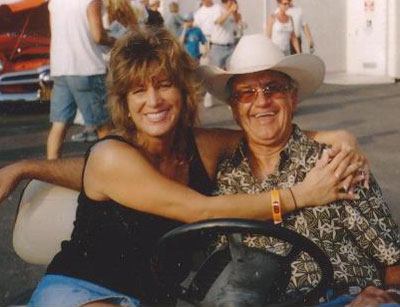 |
Leigh Buttera, daughter of the late, great car-building “Lil John” and pictured at right with Tharp, hit me up on Facebook to share her fond memories of Tharp and how he used to bunk at their house during some westward trips. “My mom said we were the hotel to the stars,” she recalled. She asked if I remembered this classic Tharp-ism:
MRDUCKS
MRNOT
OSAR
CMWINGS
LIB
MRDUCKS
I had never heard of such gibberish, I told her. And she translated: “MRDUCKS (them are ducks). MRNOT (them are not). OSAR (oh yes they are). CMWINGS (see them wings). LIB (hell I be) MRDUCKS. Tharp brought this phrase to the U.S. Nationals, '82ish maybe. That’s Texas talk; he wore it out.”
Speaking of fine-feathered friends, as mentioned Friday, a night on the town with Tharp was always an epic evening, and Olson was a firsthand witness to the show.
“I had traveled to the Dallas/Fort Worth area to represent the NHRA headquarters staff at the South Central Division annual awards banquet,” he recalled. “I arrived a day early to have dinner with Ray Murphy, who was a representative of the Mr. Gasket conglomerate that was one of NHRA’s major sponsors at the time. Unknown to me was a plan that had been hatched by Richard and Ray for Richard to pick me up at the restaurant following dinner and take me back to my hotel.
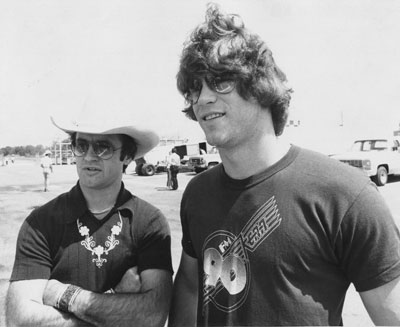
Tharp with another famous buddy, Dallas Cowboys legend Charlie Waters, one of the best defensive backs of the 1970s, at the inaugural Cajun Nationals in 1976
|
“At that time, Richard was driving a black-on-black-on black Cadillac Seville. It was tricked out with tinted windows, chrome wire spoke wheels, and the most awesome stereo system I’d ever encountered. It became immediately obvious that Richard had no intention of taking me back to my hotel, at least not until we’d hit every major nightclub in downtown Dallas. The two things I remember most were the reception Richard got at every stop and the farewell he got whenever we left. Doormen that were turning away the ‘common folk’ in droves embraced Richard and provided us with immediate entry. Once inside, Richard quickly became the center of attention. I even remember a hoard of groupies abandoning Dallas NFL football superstar and Richard’s good friend, 'Hollywood' Henderson, to flock over to Richard. ‘Hollywood’ was right behind them to pay his respects. I’ll never forget leaving one of the clubs, getting into Richard’s Seville, engine running and stereo blaring, and watching five or six of the most beautiful girls I’ve ever seen beating on the windows and begging Richard to take them with us. Richard just smiled and waved them away.
“Suffice to say, that was, by far, the most spectacular evening of club hopping I’ve ever experienced, and it told me a lot about what a major personality Richard Tharp was, and is, both at the dragstrip and away from it, especially in Texas. Since Richard’s retirement from driving, I’ve only rarely encountered him, but whenever I do, we share some big smiles, and I’m reminded of how fortunate I am to have had a chance to get to know him a bit and spend some extremely memorable time with him.”
With all of these amazing tales of his popularity, I risked a punch in the face at our next meeting by asking Tharp, “Look, you're not a bad-looking guy, but you’re no Brad Pitt. How is it that all of these women flocked to you?”
“I don’t know, just by being crazy, I guess,” he said. “It was like being a rock 'n' roll star. It was unbelievable. I don’t know why, but I sure liked it.”

 Shortly after publishing Friday’s column, we got the news we’d been dreading but expecting the last few weeks, that the world had lost Robert “Broadway Bob” Metzler, the legendary former owner/operator of Great Lakes Dragaway. The community had been following his declining condition for months, and his admittance to a hospice was certainly not a good sign.
Shortly after publishing Friday’s column, we got the news we’d been dreading but expecting the last few weeks, that the world had lost Robert “Broadway Bob” Metzler, the legendary former owner/operator of Great Lakes Dragaway. The community had been following his declining condition for months, and his admittance to a hospice was certainly not a good sign.
Anyone who knows anything about the sport’s history has heard his name or certainly heard of the track’s marquee event, the Olympics of Drag Racing. Metzler opened the track in 1955, reportedly with funds earned dealing blackjack to his former Marines at California’s Camp Pendleton, and actively ran it until the mid-1990s but remained onboard as the track’s goodwill ambassador.
 So respected and beloved was Metzler that there wasn’t a single big name from the 1970s – the height of match racing – that didn’t accept Metzler’s invitation to race there or call for a chance to do so. Other than a few brief encounters in Indy, I didn’t know Metzler beyond his reputation but have received emails from racers and fans alike who knew him and loved him. As I mentioned in the obituary I wrote Friday, a friend reported that in his last visit with Metzler, he said, "Tell all the racers I love them all," and the feeling certainly was mutual.
So respected and beloved was Metzler that there wasn’t a single big name from the 1970s – the height of match racing – that didn’t accept Metzler’s invitation to race there or call for a chance to do so. Other than a few brief encounters in Indy, I didn’t know Metzler beyond his reputation but have received emails from racers and fans alike who knew him and loved him. As I mentioned in the obituary I wrote Friday, a friend reported that in his last visit with Metzler, he said, "Tell all the racers I love them all," and the feeling certainly was mutual.
Marc and Laura Bruederle, whose photographic home base was Great Lakes, sentme with the pictures you see here of their longtime good friend, and Bret Kepner, another longtime Midwest denizen, is hard at work sculpting his tribute to “Broadway,” which I’ll publish as soon as he forwards it to me. I’m sure he’ll have more and better things to say about the man. In the meantime, check out this fine story, written by Dale Kallmann of the Milwaukee-Wisconsin Journal Sentinel, which includes great comments about Metzler from NHRA’s own Bob Frey.



















































